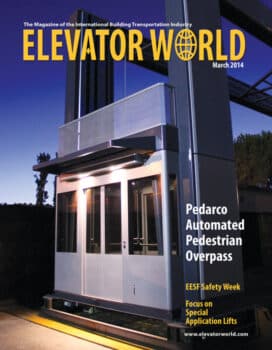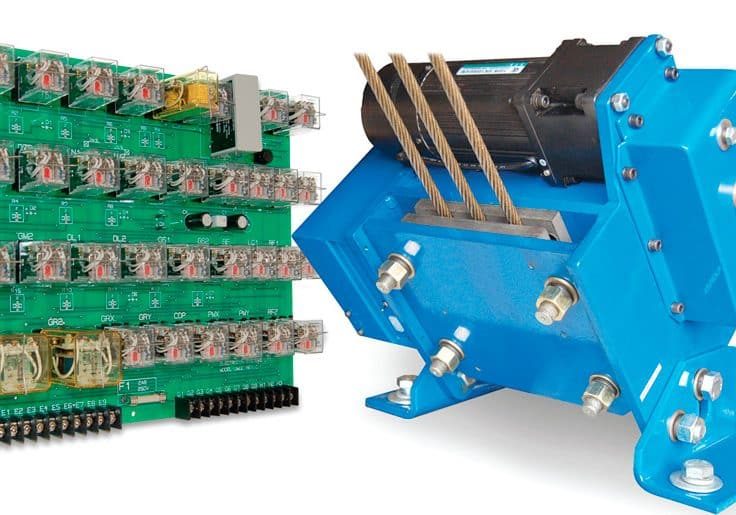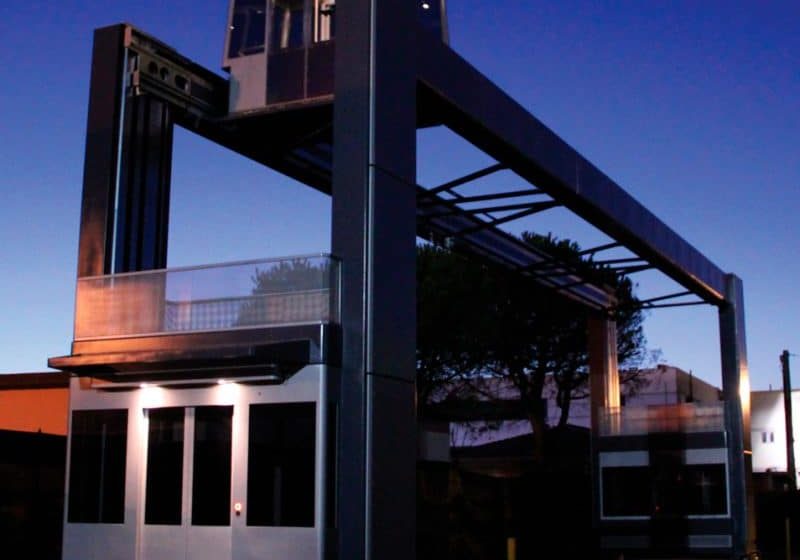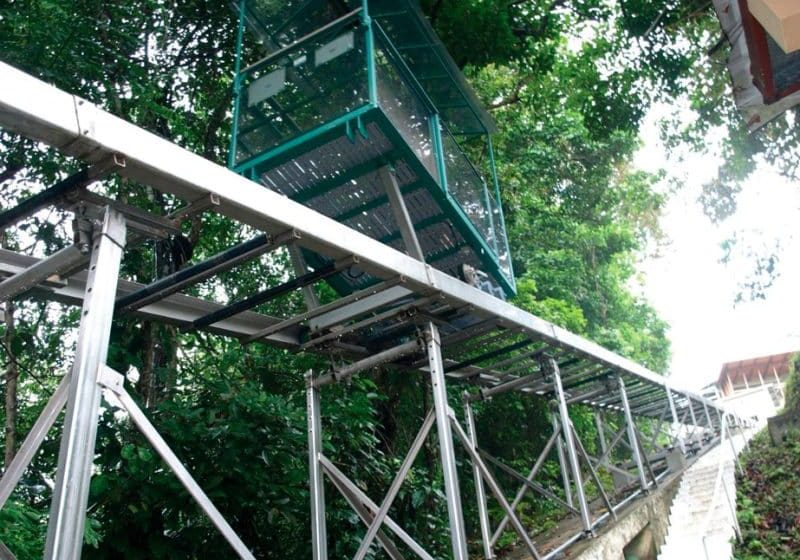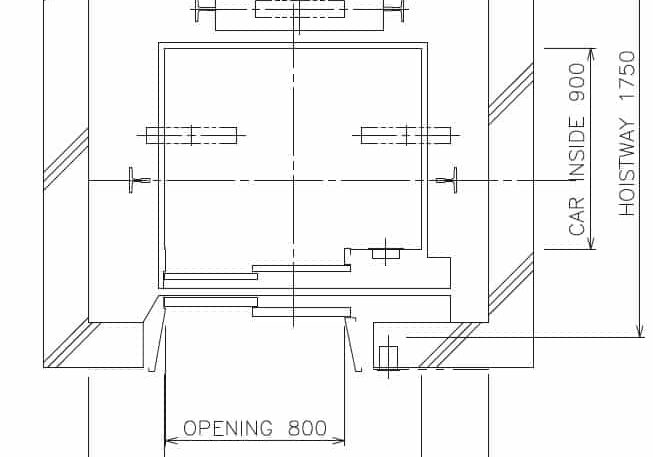The Sky Gate Escalators
Mar 1, 2014

Mount Tianmen in China has escalators installed along a treacherous trail path to add safety and accessibility.
Mount Tianmen (the Sky Gate Mountains) consists of some 16 spectacular peaks rising to heights of 1,518 m and is situated in the south of downtown Zhangjiajie in northwestern Hunan Province, China. Part of a national park since 1992, the mountains have attracted thousands of tourists from all over the world and all parts of China.
The Tianmen (Sky Gate) Cave, which, according to historical records, came into being as a result of an earthquake in 263, is regarded as the world’s tallest natural cave penetrating a cliff. It runs north and south through the upper ridge of the mountain, like a gate leading to the sky. The cave is located near the top of the mountain and measures 131.5 m high X 57 m wide X 60 m deep and presents a natural wonder, opening eyes to the majesty of the profound landscape of the mountains.
The top terminal station of the cable car is located near the mountaintop, on which a viewing pavilion enables people to command a 360° view of the grand landscape around and beneath. The pavilion is equipped with elevators inside, and an open-air cable line offers easy access for visitors going to the Tianmen Buddhist Temple lying on a nearby hilltop. Otherwise, visitors must walk along lengthy trail paths on their way for sightseeing.
Although both the top and midway parking lots became accessible by the cable car, visitors from the mountaintop had to take the cable car down to the midway station, come up to, then go down from Tianmen Cave by bus before the escalators in the upper tunnel were installed. Today, visitors from the Tianmen Cave can either take a bus down to the midway parking-lot station or go all the way back up, riding the upper-tunnel escalators to the top terminal of the cable car.
Project Background
The journey up Mount Tianmen used to begin with the 99-Twist Motorway (the Sky Road), which is nearly 11 km long. Fortunately, a cable-car system came into operation in September 2005, which greatly increased the number of visitors up to and down from the mountaintop area. However, visitors still had to climb the 999-step stairway after getting off the bus in the parking lot in order to reach the platform in front of Tianmen Cave. Then, they would have to climb back down. Exhausted from physical hardships, people moved slowly up and down the stairway, and the Tianmen Cave route often got crowded.
The tourism management wanted to improve the passenger-flow situation by means of vertical-transportation systems. According to Chen Huaping, a veteran in the Chinese elevator industry, the original solution was to install a number of 3000-kg-capacity passenger elevators. It was technically feasible, but the process for risk assessment and verifications by the authorities would be lengthy. Another disadvantage was that elevator installations would noticeably change or mar the natural outlook of the mountains, which is why the Bailong elevators — glass elevators built onto the side of a 1,070-ft.-high cliff in the Wulingyuan area of Zhangjiajie and completed in 2002 — have remained controversial until today. The involved parties finally agreed upon using escalators installed in tunnels, which would keep the natural scenery almost unchanged, and a chain of escalators for the huge rise would be a creative solution, though very difficult to carry out, especially in building the tunnels and moving the materials up onto the 1,300-ft.-high mountain ridge.
According to Lu Binyun, director of the Canny project team, the project looked so difficult to escalator suppliers that some bidders gave up, concerned about the transportation of the giant escalators up the steep mountain. He listed three major challenges in this respect:
The trucks carrying the escalator materials had to go up the 11-km-long, 99-Twist Motorway safely.
The escalator materials had to be moved to the front platform on top of the 999-step flight up from the Tianmen Cave parking lot, where they would be unloaded.
For the 14 escalators to be installed in the upper tunnel, the materials had to go past a section of inaccessible cliff leading to the lower entrance/exit of the installations, 200 m away from the front platform of the Tianmen Cave.
Assessment for solutions went on, while trust and friendship built up between Zhang Tongsheng, owner of the tourism management, and Wang Youlin, president of Canny Elevator Co., Ltd., during the bidding period. In March 2012, Canny Elevator was awarded the contract to supply 19 escalators for the two tunnels.
New Installations
In October 2013, the five escalators in the lower tunnel began to provide an alternative option for visitors to go up or down between the Tianmen Cave parking lot and front platform of the cave; that is to say, people did not have to walk all the way up and down the steep 999-step flight as the tunnel escalators’ in line arrangement provided visitors with an automatic one-way ride that was both comfortable and timesaving. The operation direction of these KLXF heavy-duty escalators could be changed to meet the needs of passenger flow. Inspired by the increased passenger moving capacity (up by 50%) and improved safety performance of the new escalators, the owner asked Canny Elevator to install five additional escalators parallel to the existing ones in the lower tunnel. The rise of these escalators is 130 m in total (2 X 20 m + 3 X 30 m). Considering the massive length of the escalators put together in line, the tunnel makes a turn between the lower three and the upper two escalators.
To create a direct access to the Tianmen Cave for visitors who have walked a long way on the trail path and walkways on the mountaintop tourism area, another 14 escalators were installed in the upper tunnel between the top entrance/exit. The top entrance/exit of this escalator arrangement is located near a section of the walkway roughly 700 m away from the top terminal station of the cable car while the lower entrance/exit on the cliff side is behind the front platform of the Tianmen Cave. These escalators are in parallel arrangement in a tunnel measuring 510 m long and 4.7 m wide to allow two-way travel. Each chain consists of seven escalators with a total rise of 200 m (20 m + 6 X 30 m). Due to the excessive length of the escalators, the tunnel also makes a turn between the lower four and upper three escalators.
Both tunnels were constructed wide enough for 1,000-step-wide escalators, but all the installations have 600-step width. It is said the smaller width is preferable for visitor flow control, as it allows only one person to stand on a step at a time. This avoids having too many people on the mountaintop tourism area at one time, which could be hazardous to visitor safety, especially on public holidays. During the National Day holidays in October 2013, a record-setting 14,700 riders went up and 7,600 riders went down the mountain.
Between two pairs of escalators lies a horizontal walkway measuring 5-10 m and, on the turn, 30 m. The walkways in-between are used to house the control cabinets of the escalators by the tunnel walls, offering an easy access for technicians and engineers in maintenance and inspection. All the escalators have an inclination of 30º, with traction machines located on the upper landing. The 20-m-high escalators have three intermediate supports beneath their trusses, and the 30-m-high escalators have five.
Trail Path
The trail path system used to be a solution to building a narrow passage on steep cliffs, on which even a goat trail was impossible. It was developed in ancient China more than 2,000 years ago by chiseling or making a series of square sockets in the cliff rock in horizontal line arrangement, sticking square timber beams into the sockets or making vertical beams to support the pavement where the slope below allowed, then fixing planks in between on the timber beams as pavement. Safety rails were attached on the open side of the wooden pavement to prevent people from falling off. However, today, concrete beams are used as a substitute material for timber.
To provide a sturdy freight passage for field workers to move the escalator materials unloaded from the cable hoist on the front platform to the lower entrance/exit of the upper tunnel for installation, a transport trail path had to be built on the inaccessible cliff. The Canny project team worked out a practical solution by building a transport trail path a few inches above the planned permanent trail path. It was to be used for the exclusive and temporary purpose of moving the 14 escalators into the tunnel. It was independently supported and reinforced from both above and beneath, with guide rails paved on it.
Brave and skilled explorers had to rope up to the top of the cliff ridge west of Tianmen Cave to lay down a metal ladder and affix it over the ridge, so the trail-path builders could have access to their jobsite on the vertical cliff. It demanded great courage and workmanship on these project pioneers as the builders’ ladder looked like a thin belt hanging vertically on the soaring cliff. It took eight months to complete the 200-m-long transport trail path between the front platform and lower entrance of the upper tunnel.
All 14 escalators had to be moved into the lower entrance of the upper tunnel in the cliff side, because its upper entrance is accessible by pedestrians only from a narrow and steep walkway. Due to the limited load for transport on the trail path, each escalator assembling unit had to be kept shorter than 6 m and lighter than 4,000 kg so as to be moved into the tunnel entrance on the guide rails paved on the curved trail path. This was a challenging task that had to be handled from the design stage.
The 20-m-high escalators were split into nine assembling units, and the 30-m-high into 11. To further reduce the moving load on the transport trail path and make work easier, the traction machines were removed from the landing units and replaced once in place for installation. Altogether, approximately 285 mT. of escalator materials were carried into the tunnel on the trail path by hand, in association with a drum hoist pulling horizontally. The last challenge in material transport was in the turn into the tunnel, where every massive assembling unit arriving at the entrance had to make a 90º turn to enter the tunnel. The job had to be organized and carried out with greatest care to prevent anyone or anything from falling off the narrow trail path, beneath which lingers a deep canyon.
Motorway Transportation
The 99-Twist Motorway starts from the foot of the mountain near downtown Zhangjiajie, winds up to the midway parking lot, then to the Tianmen Cave parking lot and finally reaches the mountaintop parking lot. It was completed in 2005; since then, it has been regarded as one of the greatest challenges in the world for adventure-driving events.
Your reporter experienced the 99-Twist Motorway by taking a tourism bus down to the midway cable-car station. Looking out of the glass screen, you feel excited, with your heart in your throat as if you were flying amid the mountain peaks. In some sections of the road, you have the cliff walls on one side and the steep canyon on the other; in other sections, you only see the deep canyons on both sides. When two buses happen to meet halfway, one has to stop in order to allow the other to make the 180º turn first. Although I did not have the opportunity to witness how the trucks loaded with massive trusses and other escalator components managed to make the turns all the way up, I could picture how they were processing up the zigzag road on the mountain slopes. It must have been an amazing job by skilled and smart drivers.
Based on a road survey, the project team carefully selected two 13-m-long trucks rated for 10 mT. loads that could manage to make the 180º turn while carrying a sufficient load. However, the trucks had to pass the deadly turn by wheeling back and forth three times as the road width allowed. For safety reasons, the load on each truck trip was controlled within 5 mT. In order to make just-in-time deliveries to the jobsite, the trucks made 228 trips from December 2012 through June 2013, during which the transport process had to break off for three months due to bad weather.
Cable Hoist
In consideration of the transport safety and costs, the Canny project team decided to pull up the escalator assembling units and other material boxes piece by piece with an existing cable-hoist system stretching overhead alongside the 999-step stairway. The 600-m-long transport cable was supported by five steel frame supports fixed on the slopes and had to be engineered again for transporting escalator materials. As the cable hoist had a load limit, the weight of each material package had to be kept well within 6,000 kg. The solution proved so effective that all the assembling units and materials were successfully pulled up by the cable hoist from the Tianmen Cave parking lot to the front platform near the end entrance of the transport trail path.
Installation
It took considerable time to construct the tunnels by directional blasting, and both were made available for installation in time. Due to the little space to keep materials in the tunnel, the assembling units had to be put together as soon as they arrived in the tunnel. The installation of the 14 escalators was carried out one by one in a top-down order (i.e., the top-located escalators were hoisted up to the top section of the tunnel and got installed there first, and the next ones followed suit). Therefore, the material transportation and process of installation had to be scheduled and organized in extreme harmonization.
In other words, the right materials for the right escalator had to be made available in the right place at the right time. That, alone, was a great systematic task for the project team! Anything wrong in schedule or work would cause big trouble in the transport process on the trail path, at the cost of losing time and money. Thanks to the exceptional teamwork between the Canny project team and the installation technicians from Zhangjiajie, the installation of the first 19 escalators was completed in September 2013, which was considered a great success.
Cable-Car System
The Tianmen Cable Car system was supplied by Poma of France. The system came into operation in September 2005 and served as the major passenger transport means for visitors to enter the tourism area of Mount Tianmen. It features one of the longest cable-car lines in the world, with a rise of 1,279 m, a total travel of 7,455 m and 96 cabins capable of handling eight people each. The cabins, manufactured by CWA Switzerland, hang on a thick, looped wire rope, 50.1 mm in diameter and slide upon 57 pylons, including three for rescue purposes.
The system, with a maximum capacity to handle 1,200 people per hour, provides a great public traffic convenience for visitors by taking them directly from downtown Zhangjiajie up to the mountaintop tourism area. The start from the lower terminal station feels fairly flat, as the cabin moves along almost horizontally in the first 2-3 km (with building roofs beneath passengers’ feet). Then, the cabin gradually ascends as it heads for the mountains. In the final 2 km, the cabin aligns more vertically (with a maximum 38.6º in rise) before making a smooth landing at the top terminal. The line also features a midway station on its way down, at the same location as the midway parking lot, to take visitors down from the Tianmen Cave parking lot by tourism bus. The cable-car system together, with the newly installed Canny escalators, have constituted convenient passenger-moving facilities with a greater handling capacity.
A Wonder-Filled Project
The successful installation of the Sky Gate escalators by Canny Elevator marks a closer step toward creating safe and comfortable vertical-transportation facilities in difficult geographic conditions.
When you come to the Sky Gate Cave in Zhangjiajie, you may marvel at the natural wonder. On the way, you’ll enjoy riding a long chain of escalators in the tunnel and witnessing a project wonder that provides a fast and comfortable ride in place of an exhausting walk up.
Specifications
Product Description
- Model: KLXF Heavy Duty for public transportation and outdoor installation
- Materials treated for the prevention of moisture and erosion
- Real-time lubrication
- Maximum rise: 36 m
- Inclination: 30°
- Velocity: 0.5 mps
- Entrance sensors for acceleration
- Step width: 600 mm with four horizontal steps
- Single/tandem traction machines on top landing
- Balustrade: stainless steel with removable covers
- Safety features: automatic fault-sensing input, brake-wear sensor, secondary brake by mechanical stopper, step-chain breakage protection and handrail-belt breakage protection
- Handling capacity: 6,000 people per hr.
- Unit lifespan: 146,000 hours (17 years)
Project Data
- Total number of escalators: 24 (five in second phase)
- Number of escalators in upper tunnel: 14
- Number of escalators in lower tunnel: 10
- Width of upper tunnel: 4,700 mm
- Width of lower tunnel: 3,300 mm (under reconstruction for the additional five escalators)
- Passage between escalators in the upper tunnel: 1,000 mm (width)
- Passages by escalators in the lower tunnel: 1,200 mm (width, which will be changed during reconstruction)
- Total rise: 200 m in the upper tunnel; 130 m in the lower tunnel
- Intermediate supports: three beneath 20-m rises, five beneath 30-m rises
Get more of Elevator World. Sign up for our free e-newsletter.

